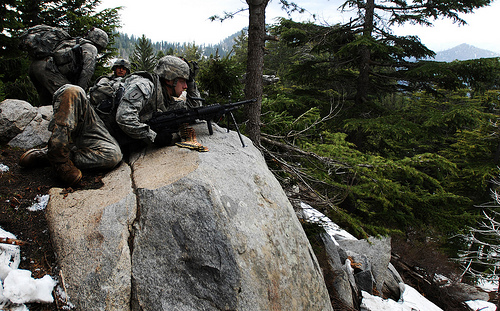
Up until this week, if you’d asked an American soldier or Marine what the worst place in all Afghanistan was, the most dangerous, bloodstained, shot at, ambushed, the least comfortable, the hardest to get in or out of, the most likely to guarantee you a one-way ticket to Dover Air Force Base in a box, they would have told you the Korengal Valley, a remote outpost in the northeastern corner of the country. Well, no longer. On Wednesday, American commanders announced the closure of the major US base overlooking the Korengal and the reassignment of the soldiers from who were stationed there. Hearing Stanley McChrystal, the American commanding general in Afghanistan justifying the withdrawal was like eavesdropping on an after-hours debate at a defense think tank. “There’s never a perfect answer,” he said. “I care deeply about everybody who has been hurt here, but I can’t do anything about it. I can do something about people who might be hurt in the future.” He added, “The battle changes, the war changes.”
It remains unclear what this withdrawal means to the evolving US mission in Afghanistan. Unsurprisingly, the Taliban has already added the Korengal to its list of battle streamers. “It’s a great victory for us,” Taliban spokesman Zabihullah Mujahed told Agence France Press by telephone from an undisclosed location. What is clear, however, is that the US way of thinking about war is changing. The new focus under General Petraeus is less on seizing and defending terrain and more on cultivating relationships with the local population and encouraging them to see them as their protectors. Ever since “the surge” in Iraq, the US military has increasingly come to resemble an international aid organization, looking at ways to weaponize development projects and stimulate economic growth in troubled regions rather than simply trying to track and kill bad guys. Ultimately, the Korengal valley was abandoned by the US because, according to US officers, the local “buy in” never happened. Numerous US overtures to build a road into the remote valley and encourage local development were rejected by Korengalis, an unusually xenophobic ethnic group which have successfully resisted every effort to subdue the valley—including the Soviets in the 1980s, the Taliban in the 1990s, and now the United States.
While many will read this pullback as a loss of nerve by General McChrystal, I see it as an encouraging sign. To paraphrase a tactical axiom attributed to Frederick the Great: he who tries to defend everything, defends nothing. In this withdrawal there seems to be a tacit understanding by US commanders about the limits of US power in Afghanistan and that they will, even after the Herculean effort that the new surge represents, be able to control only the large population centers of Afghanistan. Contrast this approach with the mindless optimism that often characterized the pre-2006 war in Iraq, exemplified by Vice President Dick Cheney’s remark during the height of the violence in 2005 when he famously declared the insurgency to be “in its last throes.”
But the Korengal situation also underscores one of the central paradoxes of modern war, namely: wherever US soldiers go, the insurgency seems to follow. It was this vexing problem that motivated Matthew Hoh, a disenchanted US Foreign Service officer to declare last year in the Washington Post, “The U.S. and NATO presence in Pashtun valleys and villages … provide an occupation force against which the insurgency is justified.” Indeed to Hoh, Korengal was the perfect embodiment of this problem: the insurgents only arrived after the Americans did and after years of fighting and forty-two US deaths, the US had achieved what could, even in the most optimistic terms, be described as a stalemate. Interestingly, the situation in Ramadi in 2005 closely resembles Korengal 2010, the key difference being that in Ramadi, US officers were beginning to have constructive conversations with the local Iraqi tribes.
Of course, war is not Stratego and while Korengal was a fascinating place that inspired some of the war’s best reportage (Sebastian Junger’s piece on Korengal in Vanity Fair and the subsequent film he directed, titled Restrepo, won the Documentary prize at the Sundance Film Festival), it was also a fantastic apparatus for producing dead Americans. And the question must be asked, why did it take so long for the American high command to recognize what was evident to every grunt who spent an hour on the ground in the Korengal? I suspect the answer to this question lies deep in the minds of the senior American leadership in Afghanistan. In retrospect, it seems likely that just as the Korengal inspired journalists to do some of their best work, so it became a dark muse for the higher levels of command—in much the same way that Khe Sanh and Ramadi were for Marine officers in Vietnam and Iraq, a place where a man’s fascination with death can collect, a place to focus the imagination, a place where you could learn to savor the horror and doom of war and maybe even get hip to it.
As Denis Johnson wrote in Tree of Smoke, his epic novel about Vietnam: “War is ninety-percent myth anyway, isn’t it?” If this is so then have we surrendered the mythic fight in Afghanistan? Or is this withdrawal perhaps also a turning point in the American military imagination, whereby we leave our 300-esque obsession with bloodshed and the clashing of spears and move toward a more nuanced methodology for sustaining our status as the world’s lone superpower? I’m not sure which is worse, death or empire, and I’m not sure how you explain what’s just happened to a young soldier who watched his buddies die in Korengal, but it’s clear that we’ve passed into a new moment in Afghanistan.







